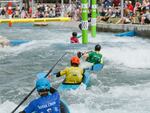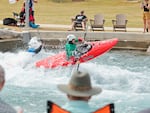
Competitors at the U.S. canoe and kayak cross slalom trials in Montgomery, Ala. float through the coarse in April 2024.
Rolando Arrieta / NPR
In the new Olympic sport of Kayak Cross the rules are quite simple.
Four kayakers position themselves side-by-side on a platform about 15 feet above an artificially-made whitewater slalom course.
They lean right up to the edge of a sloped ramp and when the race official gives the signal to go, they plunge into the rapids.
From there it’s mayhem, as they bombard down strong currents, knocking other kayakers out of the way racing in a head-to-head battle while swerving around a series of padded buoys hanging from above.
Some who see this event for the first time would say it looks like a roller derby bout on rapids.
Then midway through while barreling down the course, racers have to flip their kayak upside down to clear a course-wide obstacle that’s best described as a big Limbo bar a few feet above super fast turbulent water.
Once they’re on the other side of the bar, they have to right themselves back up and dash to the finish line. The top two from each heat advance to the next bracket until a first, second and third place winner is declared.
This adrenaline-packed whitewater event — formerly known as Extreme Slalom — makes its Olympic debut this summer.

Races in Kayak Cross describe it as "mayhem", as they bombard down strong currents, knocking other kayakers out of the way and race in a head-to-head battle while swerving around a series of padded buoys hanging from above.
Rolando Arrieta / NPR
Two-time Olympian Evy Leibfarth from Bryson City, N.C. said she can’t wait to launch off that ramp at the Summer Games.
"So exciting to race the new sport in the Olympics," she said at the U.S. Olympic Team Trials in Montgomery where she said "it's been a dream" of hers to go to Paris. "And I'm really stoked to make that a reality," she said after punching her ticket to the Summer Games competing in Canoe Slalom.
Two weeks at the second round of team trials, Leibfarth boosted her Olympic dream by becoming the first American athlete to compete in all three whitewater events; Kayak Cross, Kayak slalom and, the first in twenty years, to bring home a medal in Canoe Slalom — winning bronze in that event earlier this week.
For the athletes like Leibfarth, Kayak Cross racing is equal parts fun, kayaking skill, strength and underwater composure.
This was Olivia Spencer’s second Olympic team trials. She described what went through her mind when she capsized upstream of some prefab rocks and concrete, then struggled to roll her kayak back up. ”Just tried to make the best decision and do the best I could in my race but also to safely stay out of the way of other racers as well as do what was the safest for me in the moment,” she said.
While Kayak Cross is new to the Olympics this year, the sport has been around in other world competitions for nearly a decade.
Contact with another kayaker is permitted. Referees along the course may call out fouls for behavior that seems “dangerous and/or clearly unfair,” according to the International Canoe Federation rules. All racers must wear a life jacket, helmet and use a plastic kayak designed for this type of racing.
Some paddle blades are banned, according to Jedediah Hinkley, competition director for the American Canoe Association, the U.S. governing body of Kayak Cross competition.
“Some slalom paddles could have metal edges. You can’t have that in kayak cross,” he said.
Hinkley said racers must tape the edge of their paddle blade to avoid injury from metal or fiberglass splinters. He adds that a helmet that protects the face or gloves to prevent cuts are not required in Kayak Cross.
Hinkley says the introduction to Kayak Cross is part of a broader goal to make whitewater sports more appealing to a wider audience. “It's a new sport that is developing, he said. “It’s exciting. People like carnage. I’ve seen some gashes on the cheek for sure.”

Spectators in Montgomery, Ala. watched the U.S. Canoe and Kayak Cross Olympic trials in April 2024. Racers tore through the course — dipping, rolling and dashing.
Rolando Arrieta / NPR
At the Olympic Team Trials in Montgomery’s new whitewater park, hundreds of spectators showed up to watch Kayak Cross racing. Maurice Sterling said he had never seen this type of competition and was awed by the athlete’s agility through the rapids.
“Like when the ladies came through and all four of them where kind of bunched together. I was like, ok, what’s gonna happen? Who’s gonna roll over? Who’s gonna get knocked out? It was great.” he said.
It remains to be seen if Kayak Cross will draw more interest to the niche sport of whitewater slalom.
Sterling said he’s not quite ready to give it a try. “I like sports where I can call a time out, and this doesn’t appear to be one.” he said laughingly.
But he and his wife Tammy said they are adding this event to their Summer Olympics watch list to be, at the very least, entertained.
Copyright 2024 NPR